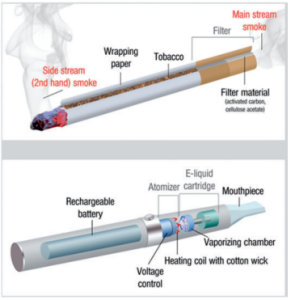Do You Really Know The Dangers Of The Vaping?(2025 Guide 1)
Cigarettes belong to the first level of carcinogens has been the public consensus, but in recent years, there is another seemingly “technological content” higher “electronic cigarettes” came out and hot sales,.
due to the e-cigarettes vaping and traditional tobacco is not quite the same way, many people think that it is compared to traditional tobacco Many people think that vaping are healthier than traditional cigarettes, so they smoke them with confidence and boldness, but is this really the case? Today, let us unveil the vape cover up:

1.the history and principles of vaping
In 2004, the real sense of mass production and sales of electronic cigarettes “such as cigarettes” was born. E-cigarettes were initially invented for the purpose of allowing people to ingest nicotine without absorbing other harmful substances produced by the burning of cigarettes, so vaping has always been used as a substitute for traditional tobacco or as a medical product to assist in quitting smoking.
The principle of vaping primarily involves the heating of e-liquid (cigarette oil) at high temperatures to produce aerosolized vapors, which smokers inhale into their lungs as if they were smoking cigarettes. The main components of vaping include a rechargeable battery, a heated atomizer cartridge in the atomizer chamber (including heating wire, oil-conducting cotton, etc., which needs to be replaced regularly), e-cigarette oil, and a smoking mouthpiece. Most products on the market are generally divided into 2 parts: the power supply part (rechargeable battery, heated atomizing core) and the heating and atomizing part (vaping oil and smoking mouthpiece).

2.the main components of electronic vaping
Usually vaping liquid contains nicotine, diluents or dissolvers (including propylene glycol, vegetable glycerin), flavoring or flavorings . The chemical composition of e-liquids produced by various manufacturers varies greatly, with the largest content of vegetable glycerin (used to dissolve nicotine, etc.) and propylene glycol (used to dilute glycerin and reduce viscosity, as well as a carrier for flavors).
Glycerin is very common in life, and it is safe to use as edible glycerin, but if the glycerin contains high impurities, these impurities will either accumulate on top of the heating wire to form deposits, or enter the lungs along with the vapor, which may irritate or even remain in the bronchial mucosa, which may be one of the reasons why many people feel an itchy throat after using vaping.
Propylene glycol is mainly used as antifreeze, humidifier and food additives in industry, and is safe to consume in compliance with national regulations, but inhaling a large amount of propylene glycol as smoke can cause irritation to the respiratory tract (somewhat like the throat-striking sensation of nicotine). While propylene glycol as a liquid is volatilized with the respiratory system, the long-term health effects of this intermittent irritation are currently inconclusive.
Flavoring fragrances and flavors are organic compounds, and there may be as many as a few hundred flavoring ingredients involved inside each tobacco oil. Carbon fiber particles are present in plant extracts, and when heated, they become carbon particles that are inhaled into the lungs with the smoke, and some oxidize to become carbon monoxide and carbon dioxide. In addition, chemical reactions between different flavors may result in the formation of unidentified substances, which may produce harmful substances when heated. It has been shown that at least 65 flavors can produce toxic substances when heated and have effects on the respiratory system, cardiovascular circulatory system, skeletal system, and skin .
The concentration of nicotine is adjustable in e-cigarettes, and it is worth noting that the use of nicotine salts has emerged as an alternative to nicotine in the e-cigarette industry over the past two years. Nicotine salts have less discomforting reactions to inhalation compared to the free alkaline nicotine and are more stable and easily dissolved, resulting in nicotine levels in e-cigarette liquids that can be as high as 60 mg/mL or even higher on the market at the present time, and thus may promote consumers ( especially youth) to increase nicotine inhalation and lead to addiction and dependence .
Heated Atomizer Core Materials The product of heating, different products may use different heated atomizer core materials, divided into heating wire and oil-conducting cotton, of which common heating wire materials include: Kanthal (ferrochromium-aluminum alloy), Ni60/Ni80 (nickel-chromium alloy containing 60% nickel or 80% nickel, also known as Nichrome), Ni200 (generally known as pure nickel wire), Ti (titanium), SS316 (3.0% nickel), and SS316 (3.5% nickel), and so on. ), SS316 (316 stainless steel), etc. The materials of the oil-conducting cotton include ceramic core, cotton core, fiberglass, etc. These materials may release some harmful substances when heated and oxidized, which are inhaled into the lungs together with the smoke.
Possible biological contamination, the organic matter in vaping may encounter biological contamination (bacteria, viruses, etc.). The declared shelf life of e-cigarette oil is usually more than one year, and if the manufacturer does not strictly carry out aseptic filling, or exceeds the shelf life, or does not use it in time after opening, it may lead to biological contamination. These bacteria or viruses are not necessarily killed by high temperatures when heated, and they may enter the lungs with the mist to produce infection.
3.the difference between vaping and ordinary cigarettes
Combustion vs atomization
Traditional tobacco needs to be burned in order to be smoked, and after tobacco is burned, a large number of harmful substances will be produced. These include tar, which is the product of incomplete combustion of organic matter in the absence of oxygen, and contains a variety of carcinogenic substances and a variety of cancer-promoting substances, so ordinary tobacco is classified as a class I carcinogen by the WHO. In addition, tar also contributes to the gradual hardening and loss of elasticity of human blood vessels, leading to cardiovascular disease. However, vaping does not burn, but is heated and atomized, and its aerosol smoke does not contain tar. E-cigarettes are generally atomized at a temperature of 250-350 degrees Celsius, which is much lower than the 700-800 degrees Celsius of ordinary tobacco, reducing the generation of harmful substances.
Smoke vs.
The generation of solid particles is also an important difference. The combustion of traditional tobacco will produce a large number of solid suspended particulate matter, from PM1.0-PM10 are available, these solid particles are sucked into the human body, adhering to the throat, trachea, lungs and other places of deposition, is unable to decompose, for years and years down the line, it will induce laryngeal, tracheal, lung cancer and other irreparable diseases. The particles produced by the atomization of e-cigarette liquid, solid particles content is very small, mainly aerosol or liquid particles, into the human body will be absorbed or eliminated, from this point of view, the hazards of e-cigarettes are also traditional tobacco small.
Harmful substances produced by combustion or incomplete combustion of traditional tobacco include nicotine, methylnitrosamine (NNAL), acrylonitrile, cadmium, naphthalene, pyrene and other addictive, disease-causing or cancer-causing substances, which, although not completely avoided in e-smoke, are present in much lower concentrations.
However, vaping relative to the emergence of new ingredients compared to traditional tobacco include a variety of solvents and diluents such as vegetable glycerin, propylene glycol, propylene glycol, etc., used to regulate the taste of the edible flavors, there may be potentially harmful.
